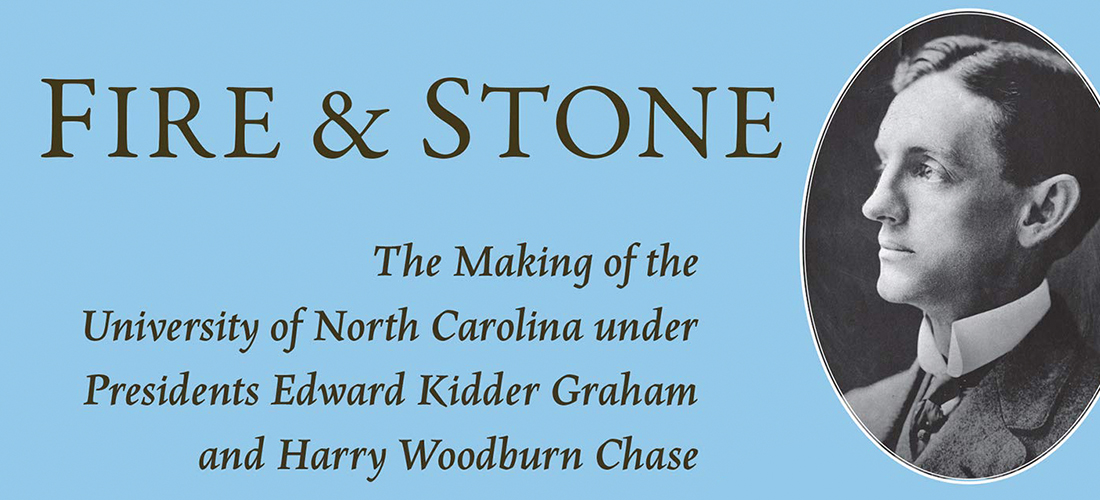
The Transformation of a University
Two presidents elevate an institution
By D.G. Martin
Looking back 100 years to the situation at the University of North Carolina at the end of World War I might give a little comfort to current-day supporters of its successors, the University of North Carolina System and the campus at UNC-Chapel Hill.
The system is looking for a new president to replace former President Margaret Spellings, who left March 1, and for the acting president, Bill Roper, who plans to step down not later than the middle of next year. Meanwhile, UNC-Chapel Hill is searching for a new chancellor to replace Carol Folt, who departed Jan. 15.
Both Spellings and Folt had been unable to work out a good relationship with the university system’s board of governors and the legislature.
In 1919, the university’s situation was, arguably, even more severe. It was reeling from the recent death of its young and inspirational president, Edward Kidder Graham, and facing the challenges of dealing with an inadequate and worn-out set of campus buildings, along with a post-war explosion of enrollees. Meeting those challenges became the responsibility of Graham’s successor, Harry Woodburn Chase.
Graham had been UNC’s president from 1913, when he was named acting president, until his death in 1918, a victim of the flu epidemic that scorched the nation at the end of World War I.
The Coates University Leadership Series published by UNC Libraries recently released Fire and Stone: The Making of the University of North Carolina under Presidents Edward Kidder Graham and Harry Woodburn Chase. The book’s author, Greensboro’s Howard Covington, explains how the “fire” of Graham and the “stone” of his successor, Chase, transformed UNC from a quiet liberal arts institution into a respected university equipped to provide an academic experience that prepared students to participate in a growing commercial, industrial, and agricultural New South.
At the time Graham became president, approximately 1,000 students were enrolled. The campus consisted primarily of a few buildings gathered around the South Building and Old Well. Classrooms and living quarters were crowded and in bad condition.
In his brief time as president, the youthful and charismatic Graham pushed the university to reach out across the state. Speaking at churches, alumni gatherings, farmers’ groups and wherever a place was open to him, he preached that universities should help identify the state’s problems and opportunities, and then devote its resources to respond to them.
He coined the phrase “The boundaries of the university should be ‘coterminous’ with the boundaries of the state.” These words came from a University Day speech by Graham, although he used the term “coextensive” rather than “coterminous.”
Leaders and supporters of the university often use this language to embrace a wider partnership with the entire state. He traveled throughout the state and delivered moving speeches about the role of education in improving the lives of North Carolinians.
Graham’s ambitious plans to transform the university were interrupted by World War I when the campus and its programs were, at first, disrupted and then commandeered by the military. His death shortly after the war ended left the university without a magnetic and motivational figure to carry out his plans and vision. That task fell upon Henry Chase, a native of Massachusetts, who had gained Graham’s trust as a teacher and talented academic leader.
Although he did not have Graham’s charisma, Chase had something else that made him an appropriate successor to the visionary Graham. He had an academic background, and a talent for recruiting faculty members who supported Graham’s and Chase’s vision for a university equipped to serve the state and gain recognition as a leading institution.
Chase had the plans, but lacked sufficient resources from the state. However, he had an energetic organizer in the form of Frank Porter Graham, a cousin of Ed Graham and a junior faculty member.
In 1921, Frank Graham helped mobilize the university’s friends that Ed Graham had inspired. Covington writes, “The campaign had been flawless. The state had never seen such an uprising of average citizens who had come together so quickly behind a common cause. Earlier rallies around education had been directed from the top down, with a political figure in the lead. This time, the people were ahead of their political leaders, who eventually came on board.”
Chase took advantage of the public pressure on the legislature to secure the resources to expand the campus. He organized and found support for university programs that included the graduate and professional training needed to serve the public throughout the state, as Ed Graham had hoped.
By 1930, when Chase left UNC to lead the University of Illinois, the UNC campus had more than doubled in size, and the student body approached 3,000, including 200 graduate students. His successor was Frank Graham.
Chase’s ride to success had been a bumpy one. For instance, in 1925, about the time of the Scopes-evolution trial in Tennessee, Chase faced a similar uprising in North Carolina from religious leaders who attacked the university because some science instructors were teaching Darwin’s theory of evolution.
The state legislature considered and came close to passing a law to prohibit teaching of evolution. During the hearings on the proposal, one such professor, Collier Cobb, planned to attend to explain and defend Darwin’s theories.
Covington writes that Chase told Cobb to stay in Chapel Hill because “it would be better for me to be the ‘Goat,’ if one is necessary on that occasion than for a man who is known to be teaching evolution to be put into a position where he might have to defend himself.”
Chase respectfully told the committee that he was not a scientist. Rather, he was an educator and he could speak on the importance of the freedom of the mind. He also countered the proposal by emphasizing the point that Christianity was at the university’s core. His strong defense of freedom of speech gained him admiration of the faculty and many people throughout the state.
But his defense of freedom was not absolute. He could be practical. When Cobb wrote a book about evolution and the newly organized UNC Press planned to publish it, Chase vetoed the idea. He explained that the book “would be regarded by our enemies as a challenge thrown down and by our friends as an unnecessary addition to their burdens.”
Chase explained, “The purposes for which we must contend are so large, and the importance of victory so great, that I think we can well afford for the moment to refrain from doing anything, when no matter of principles is involved, that tends to raise the issue in any concrete form, or which might add to the perplexities of those who will have to be on the firing line for the University during these next few months.”
Chase’s pragmatic handling of a delicate situation showed how academic leaders, perhaps all leaders, sometimes have to temper their principles in the interest of achieving their goals.
Covington writes that Chase “took the flame that Graham had ignited and used it to build a university and move it into the mainstream of American higher education.”
Without Ed Graham’s fire and Chase’s stone, UNC would not have become what it is today, one of the most admired universities in the country.
Robert Anthony, curator of the North Carolina Collection at UNC-Chapel Hill’s Wilson Library, asserts that there is a wider lesson. He writes, “In this thoughtful, skillfully written examination of the University and its two leaders during the earliest decades of the 20th century, Howard Covington reminds us that individuals with vision and determination can make a difference.” OH
D.G. Martin hosts North Carolina Bookwatch Sunday at 11 a.m. and Tuesday at 5 p.m. on UNC-TV. The program also airs on the North Carolina Channel Tuesday at 8 p.m. To view prior programs go to http://video.unctv.org/show/nc-bookwatch/episodes/





